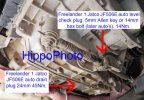Hello, im from norway and recently changed some oils(engine and automatic transmission oil) on a Freelander 1, 4td 2.0 diesel 2006.
I was wondering if someone knows the capacity to fill trans fluid to the right level, i found 4L in the internet and drained all from below(plug was right under car facing downwards). Filled it with 4L but unsure if i need to fill more..
And the brakes recently seized today(sound and high temp disks), could someone pls tell me what to look for? Also for the rear drumbrake type, if it is heavily rusted on the outside, what would be the chance to replace drum and pads for the rear axle?(ie get the drums and pads out of the rear wheels)
Thanks in advance
I was wondering if someone knows the capacity to fill trans fluid to the right level, i found 4L in the internet and drained all from below(plug was right under car facing downwards). Filled it with 4L but unsure if i need to fill more..
And the brakes recently seized today(sound and high temp disks), could someone pls tell me what to look for? Also for the rear drumbrake type, if it is heavily rusted on the outside, what would be the chance to replace drum and pads for the rear axle?(ie get the drums and pads out of the rear wheels)
Thanks in advance
